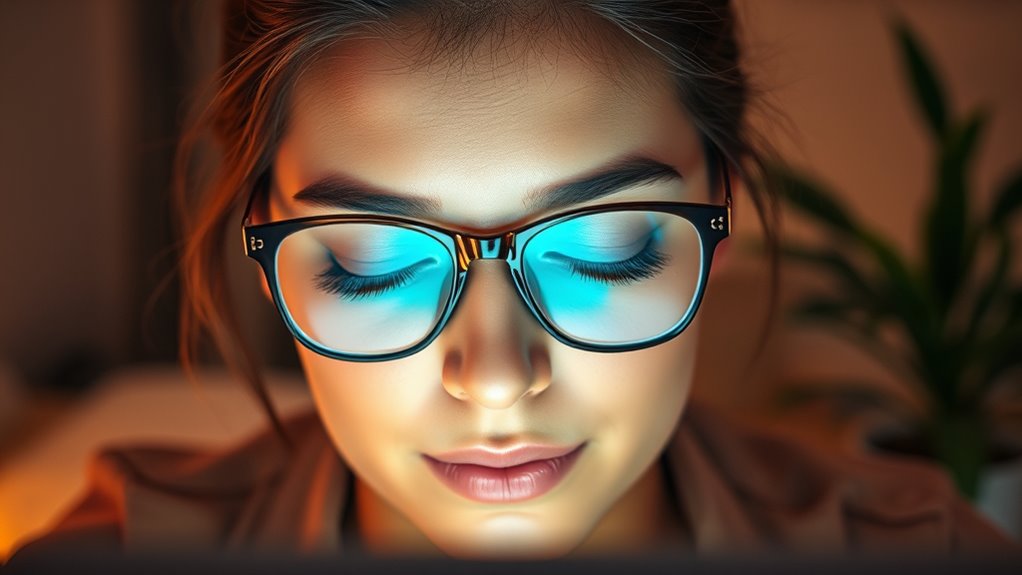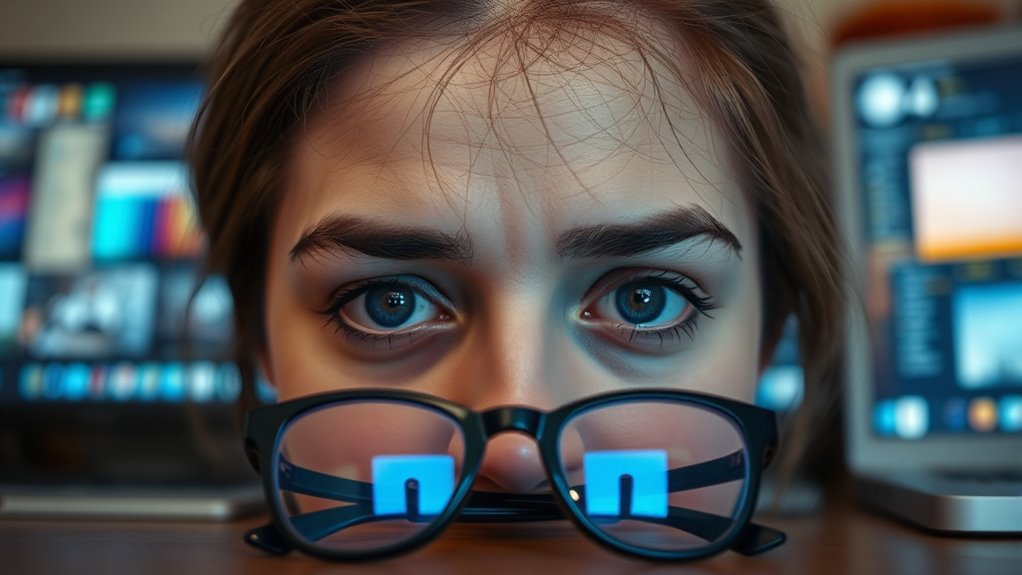Struggling with eye strain from all that screen time? You’re not alone—nearly 70% of adults face this issue. To beat digital eye strain, follow the 20-20-20 rule: every 20 minutes, look at something 20 feet away for 20 seconds. Adjust your workspace for better ergonomics, minimize glare, and take regular breaks. Don’t forget to blink and stay hydrated! There are more effective strategies to keep your eyes comfortable and healthy in our tech-filled world.
Key Takeaways
- Follow the 20-20-20 rule: every 20 minutes, take a 20-second break to focus on something 20 feet away.
- Optimize your workspace by adjusting monitor height, minimizing glare, and ensuring proper lighting.
- Maintain a comfortable distance of 25 to 30 inches between your eyes and the screen.
- Regularly blink to keep your eyes moist and reduce discomfort during extended screen use.
- Schedule annual eye exams to monitor eye health and address any digital eye strain issues.
Understanding Digital Eye Strain

Many people experience digital eye strain, a condition that’s becoming increasingly common as we spend more time on screens.
Also known as computer vision syndrome, it affects nearly 70% of adults who rely on monitors, smartphones, and tablets for extended periods. Prolonged screen time can lead to discomfort, dryness, and blurred vision, all of which impact your eye health.
The main culprits include reduced blinking, screen glare, and poor posture during those long hours. To combat these effects, consider adopting the 20-20-20 rule: every 20 minutes, take a 20-second break and focus on something 20 feet away.
Regular eye exams are essential for maintaining eye health, especially if you’re glued to your devices daily.
Symptoms of Digital Eye Strain

Digital eye strain can manifest through various uncomfortable symptoms that make screen time increasingly challenging. You might experience eye strain, leading to dryness, irritation, or burning sensations in your eyes. Nearly 70% of adults using digital devices regularly report these discomforts.
Blurred vision can also occur during or after extended screen use, making it difficult to focus on both nearby and distant objects. Additionally, you may find yourself suffering from frequent headaches, particularly around the temples and forehead.
Poor posture while using devices can lead to neck and shoulder pain, adding to your overall discomfort. If you notice difficulty focusing on screens or switching between distances, it’s a clear signal to take breaks and adjust your habits.
Causes of Digital Eye Strain

Digital eye strain often sneaks up on you due to a few key factors.
Staring at screens for long periods reduces your blink rate, leading to dryness, while blue light emission can mess with your sleep.
Additionally, glare from screens can intensify discomfort, making it essential to be aware of your environment while using digital devices.
Blue Light Emission
Although screens are an integral part of daily life, the blue light they emit can contribute considerably to eye strain. This blue light exposure, especially during long hours of computer use, can lead to discomfort and eye fatigue.
Its high energy and short wavelength characteristics are partly to blame for the strain you feel after extended screen time. While some people turn to blue light-blocking glasses in hopes of reducing eye strain, research suggests that your screen habits play a more significant role in your symptoms.
It’s important to recognize that managing your screen time and taking regular breaks can mitigate the effects of blue light, helping to keep your eyes feeling comfortable and less fatigued.
Reduced Blink Rate
Extended screen time not only exposes you to blue light but also leads to a significant reduction in your blink rate. You mightn’t realize it, but when you’re glued to your screen, your blinking frequency can drop to about one-third of normal.
This reduced blinking frequency contributes to dryness and discomfort, exacerbating symptoms of digital eye strain. Here are three ways blinking helps your eyes:
- Moisture Distribution: Blinking spreads tears across the eye surface, keeping them hydrated.
- Irritation Prevention: Regular blinks prevent tears from evaporating too quickly, reducing irritation.
- Comfort Maintenance: Consistent blinking guarantees your eyes feel comfortable during prolonged screen use.
Make a conscious effort to blink more often while using digital devices to alleviate discomfort. Additionally, maintaining air quality is crucial, as improved air can contribute to overall eye comfort during extended screen time.
Screen Glare Effects
When you’re working on a screen, glare can quickly become a major source of discomfort and eye strain.
This screen glare, caused by ambient light bouncing off your device, intensifies the symptoms of digital eye strain, leading to headaches and blurred vision.
To enhance your visual comfort, position your screens to minimize glare from windows and overhead lights.
Adjusting screen brightness and using anti-reflective coatings can also help mitigate glare effects.
If you still face significant glare, consider using matte screen protectors or modifying your workspace lighting.
Tips for Preventing Digital Eye Strain

To prevent digital eye strain, you can start by adopting a few simple habits.
Following the 20-20-20 rule, optimizing your workspace ergonomics, and remembering to blink regularly can make a big difference. Regular use of air purifiers can enhance your overall comfort by improving indoor air quality, which is essential for maintaining focus. Additionally, ensuring proper airflow around the unit can further enhance the effectiveness of your air purifier. Furthermore, using energy-efficient systems like heat pumps can contribute to a more comfortable environment by reducing overall energy demand. Staying mindful of these tips will help keep your eyes comfortable and focused.
Follow the 20-20-20 Rule
Every 20 minutes of screen time, you should take a moment to follow the 20-20-20 rule, a simple yet effective way to combat digital eye strain.
This practice helps you relieve discomfort like dryness and blurred vision. Here’s how to do it:
- Look at an object 20 feet away.
- Focus on this object for at least 20 seconds.
- Take deep breaths to relax your eyes and mind.
Optimize Workspace Ergonomics
While you mightn’t realize it, the way your workspace is set up can considerably impact your eye health.
To optimize workspace ergonomics, position your computer monitor 25 to 30 inches away, with the top of the screen at or just below eye level. This reduces eye strain and encourages comfortable viewing angles.
Make sure your chair provides good lumbar support, allowing your feet to rest flat on the floor to maintain good posture.
Adjust lighting to minimize glare, using desk lamps as needed. Pair your setup with an ergonomic keyboard and mouse, keeping them level with your elbows.
Finally, remember the 20-20-20 rule: every 20 minutes, take a 20-second break to look at something 20 feet away.
Blink Regularly and Hydrate
Even with an ergonomic workspace, digital eye strain can still sneak in if you’re not mindful of your blinking habits and hydration.
To combat discomfort and dryness, try these tips:
- Blink regularly: Make a conscious effort to blink more often. Your blinking frequency can drop to a third of normal rates during screen use, leading to dry eyes.
- Hydrate: Drink plenty of water throughout the day to keep your eyes moist and reduce irritation associated with digital eye strain.
- Take breaks: Follow the 20-20-20 rule—every 20 minutes, look at something 20 feet away for 20 seconds. This helps relax your eyes and encourages blinking.
Incorporate these practices into your routine to effectively manage eye strain.
Importance of Regular Eye Check-ups

Regular eye check-ups are vital for maintaining your vision and overall eye health, especially as you navigate the challenges of increased screen time in today’s digital age.
The American Optometric Association recommends annual eye exams for adults to monitor eye health and adjust prescriptions as needed. These thorough eye exams help identify early signs of conditions like glaucoma, which can affect millions globally.
By addressing issues related to digital eye strain, your eye care professional can provide personalized advice to enhance comfort during screen use.
With remote work and education becoming the norm, prioritizing regular eye check-ups is essential to preventing significant vision deterioration and ensuring your eyes remain healthy and comfortable in this digital landscape.
Ergonomics and Eye Health

Here are three key adjustments to take into account:
- Screen Position: Keep your computer screen 25 to 30 inches away from your eyes and 3 to 4 inches below eye level to minimize glare. Additionally, maintaining a clean environment with air purification can further enhance your visual comfort by reducing airborne irritants.
- Posture: Sit with a straight back and relaxed shoulders to support overall comfort and prevent ocular misalignment. Incorporating air purifiers in your workspace can also help reduce pollutants that may irritate your eyes.
- Lighting: Adjust your workspace lighting to counteract screen brightness and reduce external glare.
Additionally, consider implementing energy-efficient lighting solutions, as lighting can be a significant energy drain, which can contribute to a more comfortable and productive workspace environment.
Regularly evaluating these ergonomic factors can greatly improve your eye comfort and reduce symptoms of digital eye strain.
Make these changes today for healthier eyes!
The Impact of Blue Light on Eye Health

As you navigate the digital age, it’s vital to understand the impact of blue light on your eye health. Blue light emitted from digital screens, LED lamps, and even sunlight can contribute to eye strain, especially during prolonged use.
While current research shows no conclusive link between blue light from screens and serious retinal damage, excessive exposure in the evening can disrupt your sleep by slowing melatonin production. To reduce eye strain and maintain better sleep quality, consider using night mode on your devices, lowering screen brightness, and avoiding screens for 1-2 hours before bedtime. Additionally, consistent maintenance of your environment, such as using air purifiers, can help improve overall air quality and reduce allergens that may also contribute to eye discomfort.
Frequently Asked Questions
How Many Hours of Screen Time Causes Eye Strain?
Spending more than 2 hours on screens without breaks can lead to eye strain, often called computer vision syndrome.
You might notice symptoms like dryness, irritation, or headaches after extended use. If you push beyond 3-4 hours of continuous screen time, these symptoms can intensify.
To combat this, remember the 20-20-20 rule: every 20 minutes, take a 20-second break and focus on something 20 feet away.
Your eyes will thank you!
How Can We Save Our Eyes in the Digital Age?
Your eyes are like windows to your world, and you need to keep them clear.
To save your eyes in the digital age, follow the 20-20-20 rule: after every 20 minutes of screen time, look at something 20 feet away for 20 seconds.
Adjust your monitor to the right distance, blink regularly to keep them moist, and reduce glare.
Regular eye exams are essential to catch any issues early.
Take care of those windows!
How Do You Fix Eye Strain From Screen Time?
To fix eye strain from screen time, you should start by implementing the 20-20-20 rule: every 20 minutes, take a 20-second break to focus on something 20 feet away.
Adjust your screen brightness to match your room’s lighting, and keep your monitor about 25 to 30 inches away, positioned just below eye level.
Remember to blink often to keep your eyes moist, and don’t skip your regular eye exams for better health.
Does Digital Eye Strain Go Away?
Yes, digital eye strain can go away, especially with proper management. If you take regular breaks and follow the 20-20-20 rule, you’ll likely notice relief from symptoms like dryness and discomfort.
Adjusting your workspace ergonomics and screen settings can also help. Don’t forget to practice consistent eye care, like blinking regularly and doing eye exercises.
Ignoring these symptoms, however, might lead to chronic discomfort, so stay proactive about your eye health!
Conclusion
As you navigate the digital landscape, remember to give your eyes a break; they’re the windows to your world. Picture a serene forest, where your gaze drifts from the screen to the soothing greens, allowing your mind to reset. By taking simple steps to care for your vision, you’re not just combating digital eye strain—you’re nurturing clarity and focus. Prioritize your eye health, and watch as the vibrant details of life come alive, unfiltered and bright.










